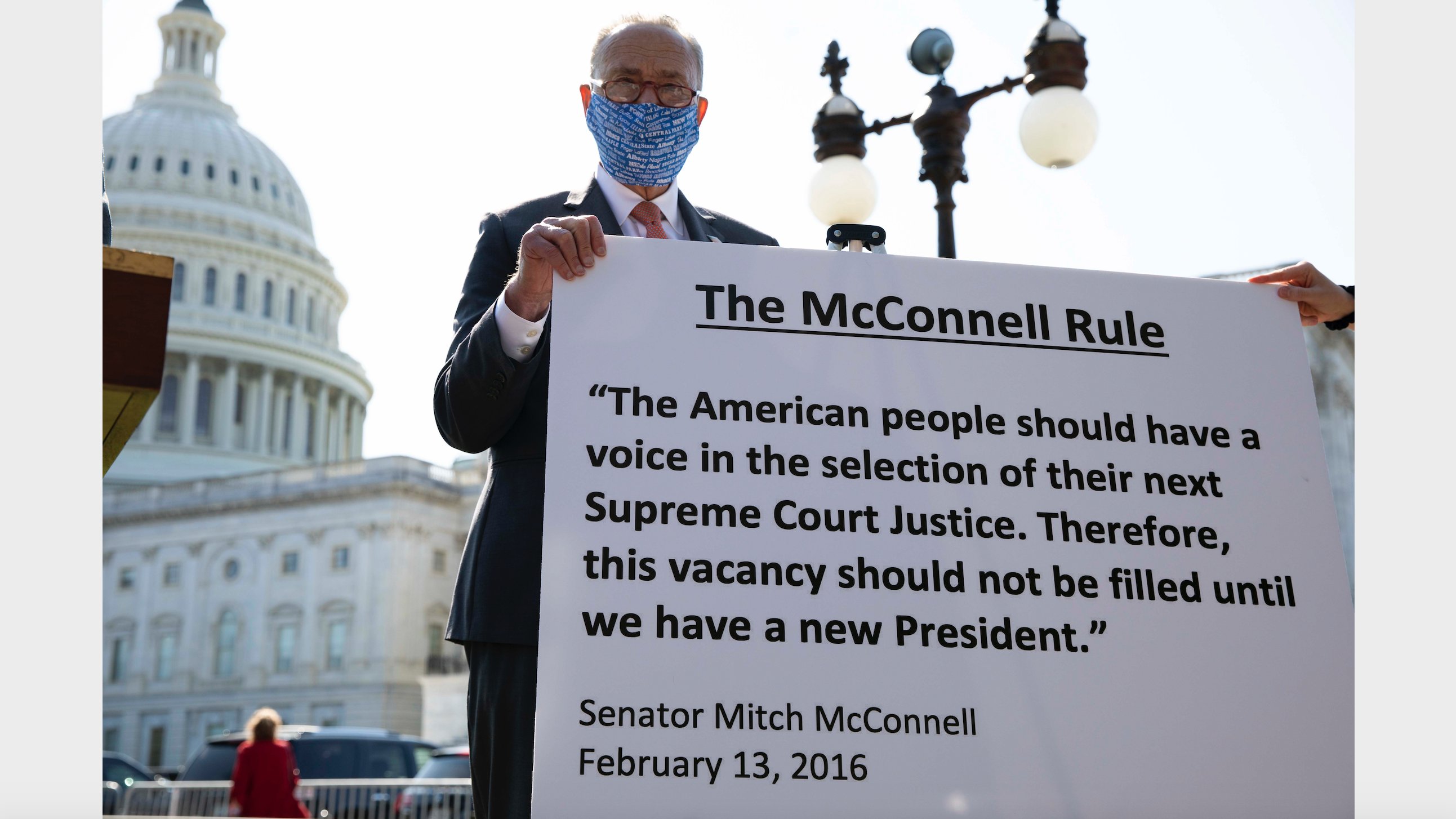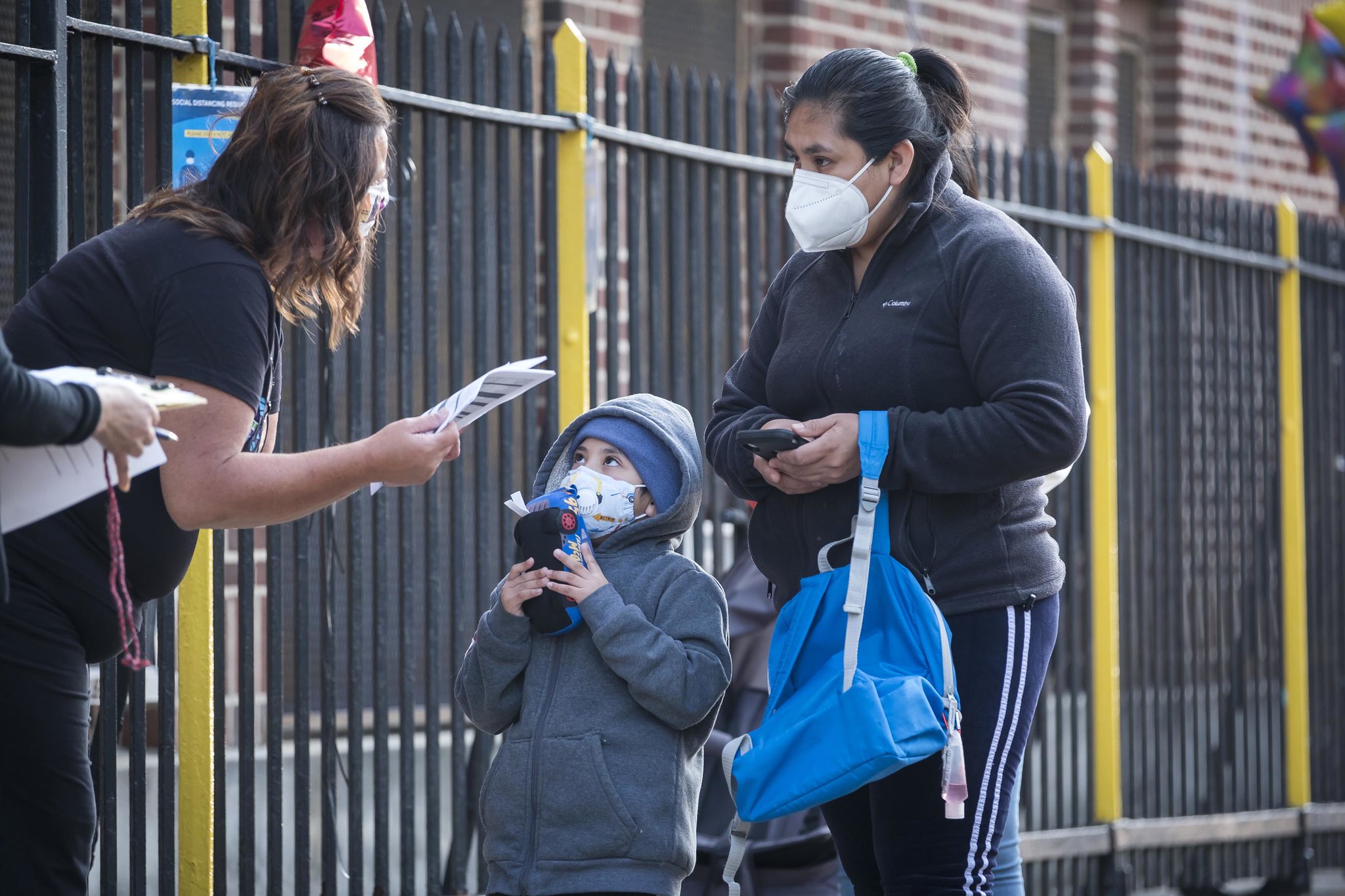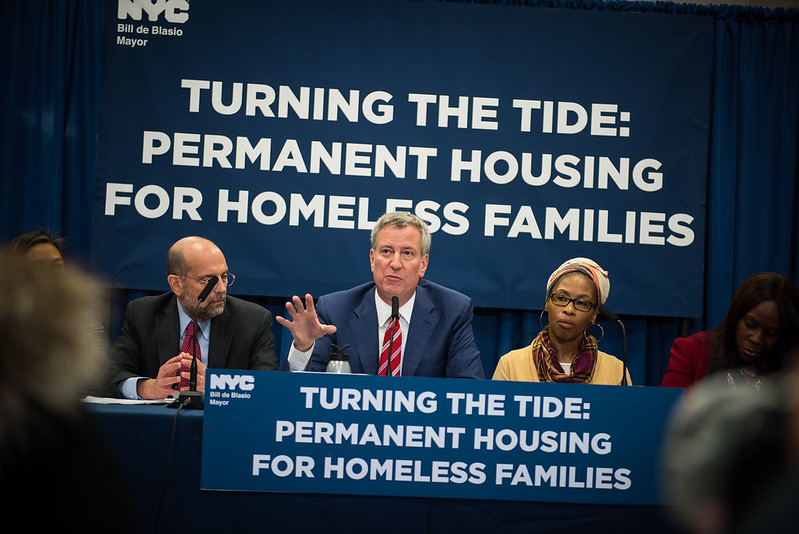This is Chuck Schumer’s Moment; Why is He Blowing it?

Senator Schumer calling out Senator McConnell (photo: @SenSchumer)
As New York-based activists, we’ve worked consistently to push Chuck Schumer to take a bolder stance against Trumpism, both as our senator and as the Senate minority leader. We’ve talked to him in person, we’ve protested at his house and his office, and we’ve flooded his phone lines. But we have never been so mystified by his lack of leadership as we have been during the Senate Judiciary Committee hearings for Supreme Court nominee Amy Coney Barrett.
Everything about Judge Barrett’s record and writings makes clear her radical right-wing ideology is a danger to all Americans. If confirmed, she will rule to strip health care away from millions of Americans during a pandemic, roll back Roe v. Wade, threaten the implementation of climate policy, and put corporations over workers and communities.
More importantly, the nomination process for Barrett is itself profoundly undemocratic and dangerous.
Voting in the 2020 elections is already happening and Senate Republicans are hypocritically pushing ahead after refusing President Obama’s 2016 nomination of Merrick Garland. With confirmed cases of COVID-19 in the Senate Judiciary committee, holding these hearings in person put lives at risk, including Senate staffers and building staff. Not to mention that Senate Republicans continue to obstruct covid relief.
With early voting underway in numerous states across the country and all polls pointing to majority support for Joe Biden, these hearings demonstrate Senate Republicans’ utter contempt for the will of the people -- just four years after Mitch McConnell obstructed the Garland nomination, made well ahead of the election.
And as the hearings unfolded, it was clear that the nominee herself has little regard for the law and instead intends to carry out a totalitarian agenda through the court. She refused to comment whether she supports a peaceful transfer of power; she refused to acknowledge that voter intimidation is a crime; and she refused to recuse herself from a case involving the Trump campaign if and when he challenges the results of the election.
This is a make or break moment for our democracy, and for all people.
So why does it seem like Schumer and Senate Democrats don’t understand that?
Democratic Senators including Dianne Feinstein, Patrick Leahy, Dick Durbin, Sheldon Whitehouse, Amy Klobuchar, and Chris Coons have met with Barrett, when they could have refused to do so. Senator Feinstein opened her questioning by asking irrelevant questions about Barrett’s children. Later, Feinstein inexplicably declared she was “impressed” with Barrett, handing Republicans a useful soundbite. And many Democratic Judiciary members participated in person in a hearing in which Republican Senator Mike Lee, who was recently diagnosed with COVID-19, refused to consistently wear a mask.
The whole process is wrong. The Senate should not be holding hearings three weeks before an election during a deadly pandemic. Senate Democrats should not be cooperating with Lindsey Graham or asking Barrett polite questions about her family, and they certainly shouldn’t be feeding the narrative that Barrett’s confirmation is inevitable.
As activists and organizers, we know that we don’t only fight for outcomes that are easy or guaranteed. It’s the hard battles, the ones that seem impossible, that need our ferocity even more.
Senator Schumer is the Democratic Senate Leader, it is his job to lead a caucus-wide messaging and procedural strategy to disrupt, delay, and discredit the hearings.
That’s not happening.
Instead, it has fallen to activists like us to write the memos detailing the tools available to him to delay the process, including denying a quorum and coordinating with House Democrats to introduce ‘must-pass’ legislation. It has also fallen to us to highlight the dangers of holding an in-person hearing; while Schumer tweeted about the danger of multiple confirmed and suspected cases covid among GOP senators on the Judiciary Committee, we were the ones who showed up in hazmat suits outside the Senate on Monday morning to emphasize the danger of COVID-19.
When Amy Coney Barrett refused to forcefully endorse a peaceful transfer of power, every Democrat could have stood up and walked out of the hearing. But they didn’t.
Polls show a majority of Americans don’t think the hearings should continue and say the seat should be filled by the next President.
On Wednesday, Judiciary Democrats muscled up and denied a quorum. That’s a start. But they need to go even farther. Senator Schumer and his colleagues should be bold and courageous in this fight and boycott the committee vote on Thursday -- as courageous as the activists who are protesting daily outside the Supreme Court and as bold as the majority of people who want the Senate to focus on covid relief instead of these sham hearings.
Senator Schumer should do his job. Or the people of New York will find someone who will.
***
Jaron Benjamin is an activist. Liat Olenick is a leader of Indivisible Nation BK. On Twitter @Jaronimoh & @Liat_RO.
***
Have an op-ed idea or submission for Gotham Gazette? Email This email address is being protected from spambots. You need JavaScript enabled to view it.
Throughout Shifting Education Experiences, New York is Failing Immigrant Families

A student reporting to school (photo: Ed Reed/Mayoral Photography Office)
From English-only robo calls and critical emails to online-only surveys and a dearth of information in community media outlets, immigrant families have been left out of remote learning in New York, and they are confused and deeply concerned.
COVID-19 forced schools across the nation and in New York State to close in mid-March, quickly exacerbating pre-existing inequities in New York’s education system through the transition to remote learning. For New York’s immigrant students and their families in our public schools, the lack of clear and timely communication in families’ home languages prevented many from making informed decisions during a historic crisis and also shut many immigrant youth out of an education for months.
Approximately 38% of New York’s school-age children have at least one foreign-born parent, and youth learning to speak, read, and write in English (English Language Learners, or ELLs) account for nearly a quarter-million of the state’s students. When we fail to meet ELLs' needs, we fail their families and their communities, and we fail all New Yorkers.
It is especially important for schools to communicate effectively with immigrant families and actively support their engagement because survival is consuming a large portion of their bandwidth.
Immigrants tend to work in the industries hardest hit by the COVID-19 pandemic, live in the areas hardest hit by outbreaks, and make up a disproportionate number of those killed by the virus. In New York, nearly a quarter of residents are immigrants and they make up a third of the state’s front line workers, while numerous others have lost their employment due to the pandemic. These at-home crises impede ELLs’ academic success and create social and emotional trauma.
As school buildings closed and transitioned into remote learning, educators, advocates, and community leaders quickly rang the alarm that ELLs and children of Limited English Proficiency (LEP) parents were harder to reach and would require additional outreach and support to get integrated into virtual classrooms. Myriad obstacles for low-income immigrant families, such as lack of access to technology, housing, child care, and food, were exacerbated by the inconsistent and inappropriate means of communication employed by districts and schools across the state.
For years, the absence of timely, in-language communication has left many of New York’s ELLs behind. Under COVID-19 remote learning, these barriers have only intensified. Immigrant families fear that these problems will remain throughout the academic year that has just begun.
With Interim Commissioner Betty Rosa now at the helm, the New York State Education Department (NYSED) has a real opportunity to address the deficiencies of these past months and launch proactive strategies to reach and meaningfully engage our ELL and LEP families.
NYSED should require school districts to track and improve school engagement with immigrant students and families, and therein combat inequities in instruction and learning. This data will help policymakers and advocates identify what areas are in most need of improvement to best serve our immigrant students and families.
NYSED should also require that disaggregated, district-wide and school-by-school engagement and attendance data be made publicly available in all districts with large immigrant populations. Disaggregated data will help reveal which districts have communicated most effectively with immigrant families, and those that need support. Only with real transparency will school districts be accountable to use the limited resources they have in targeted and equitable ways and stop excluding our most vulnerable students from being integrated into new fully remote and hybrid school systems.
***
Daisy Muñoz is a graduate student at New York University who worked closely over the summer with the New York Immigration Coalition and with the NY-AFFIRMs Coalition, which advocates for full and fair resources for New York’s English Language Learners.
***
Have an op-ed idea or submission for Gotham Gazette? Email This email address is being protected from spambots. You need JavaScript enabled to view it.
Upper West Side Saga Exposes City’s Ongoing Failures on Housing and Homelessness

Mayor de Blasio addressing housing plans (photo: Edwin J. Torres/Mayoral Photography Office)
New York City’s recent refusal to stand up to wealthy Upper West Siders is just another instance in an unending pattern of failures on housing and homelessness.
The saga of the Lucerne is emblematic of the interplay between the powerful and the powerless in New York City. In an effort to combat the spread of COVID-19, the de Blasio administration (after fierce advocacy from the Homeless Can’t Stay Home campaign) moved thousands of unhoused people from crowded shelters where social distancing is impossible to unused hotel rooms—one such hotel being the Lucerne on the Upper West Side.
Just days after the Lucerne welcomed its new residents, a now-15,000 member private Facebook group called Upper West Siders for Safer Streets formed, calling for the unhoused men at the Lucerne to be removed from the neighborhood, referring to them as “scum'' and “trash.” At the same time, UWS Open Hearts Initiative, a coalition of Upper West Siders committed to “compassion in our backyard,” organized to support the men at the Lucerne.
While the emergency nature of the move created some difficulties on the front-end, the shelter provider swiftly addressed community concerns through increased staffing and on-site services. Organizations like UWS Open Hearts Initiative also stepped up to provide supplemental support and resources and serve as a model for shelter-community integration.
Nonetheless, Mayor Bill de Blasio caved to the monied voices of the Upper West Siders for Safer Streets, and now the men are slated to be moved from the Lucerne to a hotel in the Wall Street area.
The city’s failure to prioritize the wellbeing of the men at the Lucerne is not an isolated incident and represents a consistent lack of leadership on housing and homelessness. As of July 2020, 58,089 New Yorkers were sleeping in the city Department of Homeless Services-run shelters each night—a sizable increase from the 53,615 New Yorkers sleeping in such shelters when de Blasio took office in January 2014.
But, it’s important to remember that our homelessness crisis is fueled by our affordable housing crisis—they are intrinsically linked. The deference that the city has shown to exclusionary neighborhoods like the Upper West Side has greatly contributed to our affordable housing crisis.
The city itself conducted a study on Mayor de Blasio’s housing strategy that found that building affordable housing in wealthy neighborhoods like the Upper West Side could create more affordable units at a lower cost to the city. However, as the city’s affordable housing map shows, this advice went ignored.
When compared to Brooklyn Community Board 5 in East New York and Bronx Community Board 3 in the South Bronx, Manhattan Community Board 7 in the Upper West Side is an affordable housing desert. Below is a breakdown of the new affordable housing constructed since Mayor de Blasio took office in each of these areas:
Not only has the Upper West Side constructed far less new affordable housing than Brooklyn CB5 and Bronx CB3, but it has hardly created any new affordable housing for tenants of extremely low (30% of AMI) or very low (50% of AMI) income.
Furthermore, the bulk of newly-constructed affordable housing units on the Upper West Side are on its outskirts—the borders with Morningside Heights in the north and Hell’s Kitchen in the south. Only a single new affordable unit has been built in the heart of the Upper West Side, at 214 West 72nd Street.
In fact, data indicates that the Upper West Side isn’t just diametrically opposed to housing the men at the Lucerne, housing the homeless, or even affordable housing in general, but rather all new housing. Since 2010, the Upper West Side has actually lost housing—in the midst of an affordable housing crisis.
Rather than following its own advice and building affordable housing in neighborhoods like the Upper West Side, the de Blasio administration has deferred to the wealthy interests of those neighborhoods and maintained their status quo.
Neighborhoods like the Upper West Side have played a direct role in our city’s homelessness and housing crisis. It is time for them to take responsibility, and that starts with housing people experiencing homelessness in their neighborhood, and continues with building new affordable housing there too.
***
Michael Sutherland is a Research & Policy Associate at Housing Rights Initiative. On Twitter @msuthnyc & @housingrightsny.
***
Have an op-ed idea or submission for Gotham Gazette? Email This email address is being protected from spambots. You need JavaScript enabled to view it.





